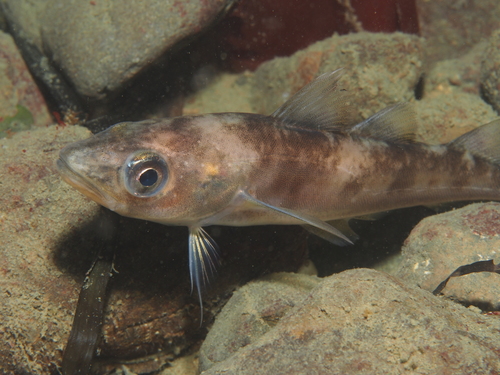
Alaska pollock
The Atlantic bluefin tuna (Thunnus thynnus) is a highly migratory, large pelagic fish renowned for its size, speed, and commercial value. It plays a crucial role in the marine ecosystem and is a top predator. This species is also culturally and economically significant, particularly in the sushi industry.
10 15 years
Lifespan
30 - 91 cm
Length
Least Concern
Conservation Status
35 km/h
Swimming speed
Carnivorous, Planktivorous
Diet
Seasonal Migration
Migration
Appearance Overview
The Atlantic bluefin tuna is a large, streamlined fish with a metallic blue body and a silvery underside. It has two dorsal fins, with the second being taller than the first, and a series of small finlets running down its back and belly.
Color
Dark metallic blue on top, silvery underside
Dorsal Fins
Two, with the second taller than the first
Finlets
Small finlets running down back and belly
Body Shape
Streamlined, torpedo-shaped
Length
Up to 13 feet (4 meters)
Weight
Up to 2,000 lbs (900 kg)
Diet
Carnivorous, feeding on a variety of fish, squid, crustaceans, and eels.
Feeding Behavior
Highly active predator, using speed and powerful muscles to chase down prey. They often hunt cooperatively, herding and surrounding schools of smaller fish.
Social Behavior
Forms large schools, especially during migration and spawning. Schools may be segregated by size and age. They are known for their long-distance migrations across oceans.
Commercial Relevance
Extremely high value, especially in the sushi and sashimi markets. A single fish can be sold for tens or even hundreds of thousands of dollars, particularly in Japan.
Conservation measures
Subject to strict fishing quotas and regulations managed by international bodies like ICCAT. Conservation efforts also include tagging programs to monitor populations and migration patterns, and research into sustainable aquaculture.
Status
Varies by region; some populations are considered endangered, while others are overfished.
Threats
Overfishing is the primary threat, driven by high demand for sushi and sashimi. Other threats include bycatch in fishing gear intended for other species, and potentially climate change affecting their prey distribution and spawning habitats.
Habitat Distribution
Depth Range
Typically found in surface waters to depths of 50-500 meters, but can dive to depths of over 1,000 meters.
Geographic Range
Western and Eastern Atlantic Ocean, including the Mediterranean Sea.
Preferred Environment
Prefers temperate and subtropical waters. Undertakes long migrations across the Atlantic for feeding and spawning.
Reproduction and Life Cycle
Breeding Habits
Spawns in warm waters, primarily in the Mediterranean Sea and the Gulf of Mexico. Spawning occurs in specific areas and times, typically in spring and summer.
Development Stages
Eggs hatch into larvae, which are planktonic. They grow rapidly, developing through juvenile stages before reaching maturity. Growth rates can vary depending on environmental conditions and food availability.
Fecundity
Highly fecund; a single female can produce up to 30 million eggs per spawning season. The eggs are pelagic, meaning they float freely in the water column.
Maturity Age
Reaches sexual maturity at around 4-8 years of age, depending on the population and environmental conditions.
Faqs about Alaska pollock
How long do Atlantic bluefin tuna live?
Atlantic bluefin tuna can live up to 40 years, although this is rare due to fishing pressure.
Where are Atlantic bluefin tuna found?
They are found in the Atlantic Ocean, from the Mediterranean Sea to the Gulf of Mexico, and from Newfoundland to Brazil.
Can I eat Atlantic bluefin tuna?
Yes, but it's crucial to choose sustainably sourced bluefin tuna. Look for certifications or recommendations from reputable organizations.
How fast can Atlantic bluefin tuna swim?
Atlantic bluefin tuna can reach speeds up to 43 mph (70 km/h) when chasing prey.
What do Atlantic bluefin tuna eat?
They primarily eat smaller fish like herring, mackerel, and sardines, as well as squid and crustaceans.
How many eggs do they lay?
Females can release millions of eggs during spawning season.
How can I identify an Atlantic Bluefin Tuna?
Atlantic bluefin tuna can be distinguished by their large size, metallic blue color, and the series of finlets along their back and belly.
Are Atlantic bluefin tuna warm-blooded?
They are warm-blooded, maintaining a body temperature higher than the surrounding water, which helps them with speed and endurance.
How is bluefin tuna fishing regulated?
International organizations like ICCAT set fishing quotas, and national governments enforce these regulations.
What is the record weight for an Atlantic Bluefin Tuna?
The record weight is around 1,496 lbs (679 kg), though larger specimens have been reported anecdotally.
Copyright @ Nature Style Limited. All Rights Reserved.
 English
English